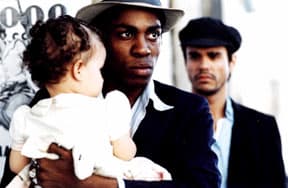Madame Satã tells the true life story of Brazilian legend Joao Francisco, a flamboyant yet troubled drag queen who made his mark in the '40s up until his death in 1976. This film starts in 1932 at the bohemian district in Lapa, Brazil, where Francisco dreams of being a cabaret singer. Poor, black, illiterate and gay, Francisco (newcomer Lázaro Ramos) scrapes by working as the dresser for diva Vitória dos Anjos (Brazilian star Renata Sorrah) until Francisco quits after an explosive argument with Anjos and the club's owner, Gregório. "There's something eating me up inside," the volatile Francisco tells a friend.
Francisco retreats into Lapa's underworld of pimps, prostitutes and thieves, as well as his own surrogate family, made up of "wife" Laurita, a charming prostitute; their daughter; a hustler named Taboo; Francisco's teenage lover, Renatinho; and Amador, the owner of the seedy Blue Danube club, which is their second home.
However, Gregório seeks revenge by falsely accusing Francisco of theft, which lands him in jail. When Francisco is freed, he fulfils his dream by launching his drag act at the Blue Danube to great acclaim. After a second show, a drunk hurls racist and homophobic slurs at Francisco who retaliates with a gun.
First-time director Karim Ainouz does a fine job capturing the squalor and stigma of Francisco's life with a lively handheld camera and an earthy graininess filmed in 35 mm. The problem lies with Ramos, who vividly presents an enraged Francisco but doesn't reveal the demons that drive him.
Further, North American audiences may not fully appreciate the significance of Francisco's true life story. In a too-brief epilogue, the award-winning film states that Francisco, after serving 10 years in prison, became a wildly successful carnival costume designer and performer of characters, including Madame Satã (Satan). (Mongrel Media)
Francisco retreats into Lapa's underworld of pimps, prostitutes and thieves, as well as his own surrogate family, made up of "wife" Laurita, a charming prostitute; their daughter; a hustler named Taboo; Francisco's teenage lover, Renatinho; and Amador, the owner of the seedy Blue Danube club, which is their second home.
However, Gregório seeks revenge by falsely accusing Francisco of theft, which lands him in jail. When Francisco is freed, he fulfils his dream by launching his drag act at the Blue Danube to great acclaim. After a second show, a drunk hurls racist and homophobic slurs at Francisco who retaliates with a gun.
First-time director Karim Ainouz does a fine job capturing the squalor and stigma of Francisco's life with a lively handheld camera and an earthy graininess filmed in 35 mm. The problem lies with Ramos, who vividly presents an enraged Francisco but doesn't reveal the demons that drive him.
Further, North American audiences may not fully appreciate the significance of Francisco's true life story. In a too-brief epilogue, the award-winning film states that Francisco, after serving 10 years in prison, became a wildly successful carnival costume designer and performer of characters, including Madame Satã (Satan). (Mongrel Media)
